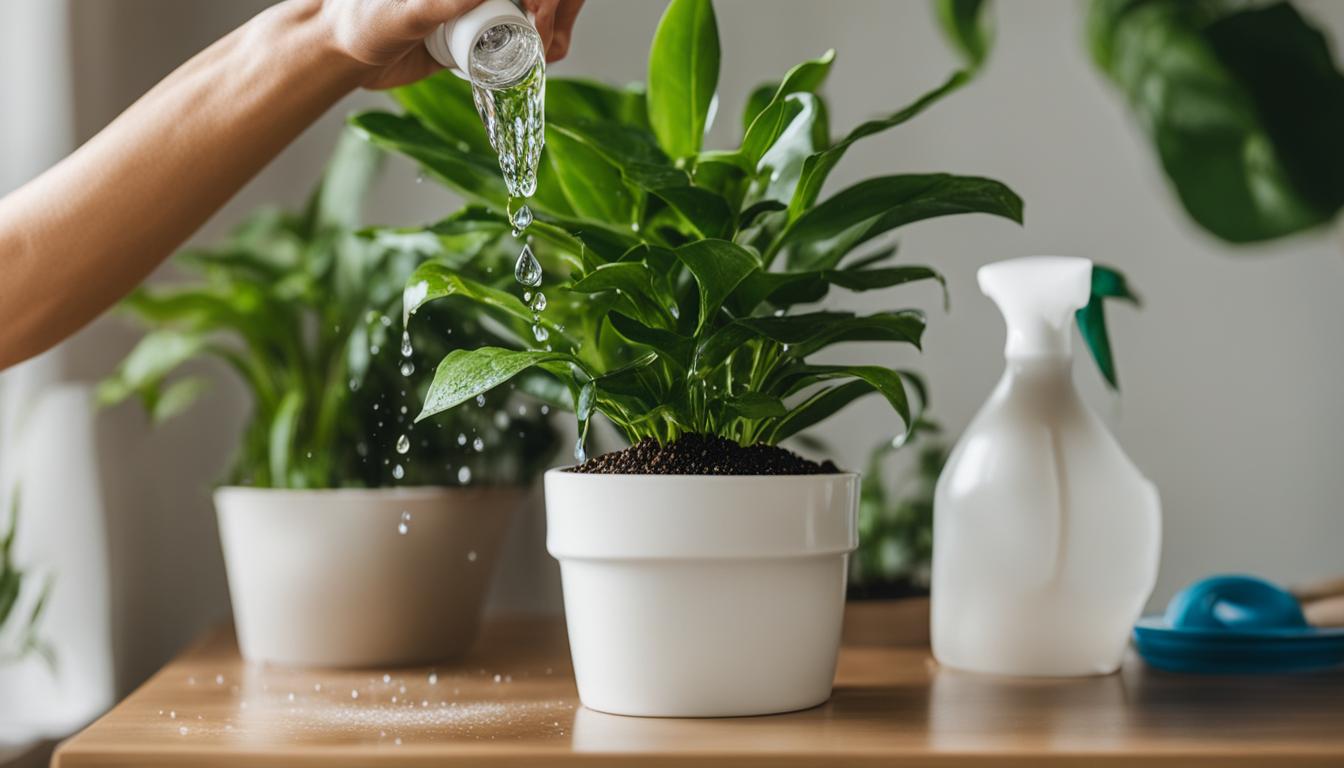
Keeping indoor plants healthy and thriving doesn’t have to break the bank. With these budget-friendly tips, you can give your plants the care they need without overspending.
From watering techniques to homemade plant food, there are plenty of cost-saving options to keep your indoor plants in great shape.
Key Takeaways:
- Learn how to judge watering needs without expensive sensors by using your fingertip to gauge soil moisture.
- Clean and shine your indoor plant leaves using simple household items like a gentle shower or a milk-soaked sponge.
- Create your own homemade plant food using baking powder, Epsom salts, saltpeter, ammonia, and water.
- Choose the right potting mixture for your indoor plants by creating your own using compost, river sand, and washing out excess salts.
- Revive dried out potting soil by adding a few drops of dishwashing soap to the water used for watering.
Judge watering without a ‘sensor’
When it comes to watering indoor plants, electronic sensors may be expensive and not always accurate. But fear not, there’s a simple and budget-friendly alternative to judge when your plants need watering.
All you need is your fingertip! By feeling the surface of the soil and digging your finger into the soil at the side of the pot, you can easily determine if your plants need water or if they can wait a little longer.
Most indoor plants prefer slightly damp soil, similar to a squeezed-out sponge. If the soil feels dry to the touch, it’s a sign that your plants are thirsty and need watering.
On the other hand, if the soil feels wet or overly saturated, it’s best to hold off on watering until it dries out a bit. This simple technique allows you to assess the moisture level of your plants’ soil without the need for expensive gadgets.
How to gauge moisture with your fingertip:
- Feel the surface of the soil – If it feels dry, it’s time to water.
- Dig your finger into the soil at the side of the pot – If it feels dry, water your plants.
- If the soil feels wet or overly saturated, hold off on watering until it dries out a bit.
Additionally, knowing the wet and dry weights of your pots can also help you determine when it’s time to water. By weighing your pots after watering and again when they feel light, you can establish a baseline for each plant’s hydration needs.
By using this simple finger test and paying attention to your plants’ moisture requirements, you can easily judge when to water your indoor plants without relying on expensive sensors. It’s a cost-effective and reliable way to keep your plants happy and healthy.
Cleaning and Shining Leaves
When it comes to keeping your indoor plants looking their best, cleaning and shining their leaves is an essential task. Not only does it improve their appearance, but it also allows them to breathe and absorb sunlight more effectively.
Instead of spending money on expensive leaf polish, you can achieve the same results using simple household items.
One method is to give your plants a ‘rain’ by placing them in the shower or gently rinsing their leaves outdoors. The gentle flow of water will remove dust and dirt from the leaves, leaving them refreshed and clean.
For an extra shine, you can dampen a sponge with milk or even mayonnaise and gently wipe each leaf. This natural approach will enhance the natural gloss of the leaves without harming your plants or breaking the bank.
To summarize, keeping your indoor plant leaves clean and shiny doesn’t have to be complicated or expensive. A gentle rinse and a wipe with a milk-dampened sponge can do wonders for their appearance.
By opting for these budget-friendly cleaning methods, you can ensure that your indoor plants not only thrive but also look their best.
Comparison of Leaf Cleaning Methods
| Method | Effectiveness | Cost |
|---|---|---|
| Shower rinse | High | Low |
| Milk-dampened sponge | Medium | Low |
| Commercial leaf polish | High | High |
The table above provides a comparison of different leaf cleaning methods. While commercial leaf polish may be highly effective, it comes at a higher cost. On the other hand, the shower rinse and milk-dampened sponge methods offer a more affordable alternative without compromising on effectiveness.
Make your own plant food
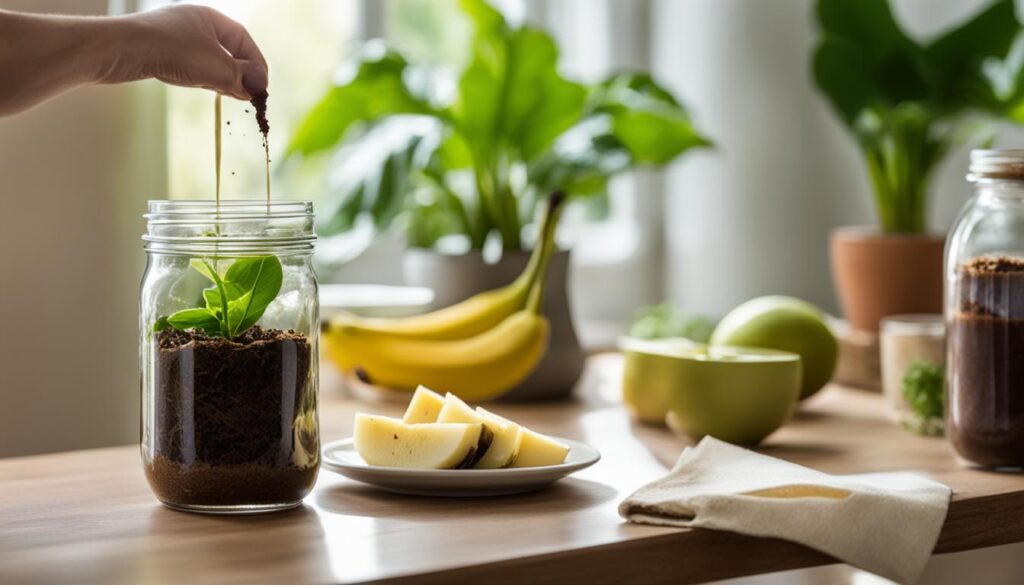
When it comes to nourishing your indoor plants, you don’t have to rely on expensive commercial plant foods. Instead, you can save money and make your own plant food right at home. By using common household items, you can provide your plants with the nutrients they need to thrive.
One easy and affordable recipe for homemade plant food consists of baking powder, Epsom salts, saltpeter, ammonia, and water. Simply mix these ingredients together and use the mixture to water your plants once a month. This DIY plant food will help promote healthy growth and vibrant foliage.
Another budget-friendly option is to repurpose the water from your aquarium when you clean it. This water is rich in nutrients and can be used to feed your indoor plants. Not only does this save money, but it also reduces waste by recycling water that would otherwise be discarded.
Homemade Plant Food Recipe
| Ingredients | Amount |
|---|---|
| Baking Powder | 1 tablespoon |
| Epsom Salts | 1 tablespoon |
| Saltpeter | 1 tablespoon |
| Ammonia | 1 tablespoon |
| Water | 1 gallon |
By making your own plant food, you can ensure that your indoor plants are getting the nutrition they need, all while saving money. It’s a win-win situation for both your wallet and your plants.
Potting Mixtures
Choosing the right potting mix is essential for the health and growth of your indoor plants. While commercial options are convenient, they can be quite expensive. Fortunately, you can make your own affordable potting mix using simple ingredients.
A homemade potting mix can be created by combining compost or leaf mold from your garden with river sand. The compost or leaf mold provides organic matter and nutrients, while the river sand helps with drainage. It’s important to wash the river sand before using it to remove any excess salts that could harm your plants.
Here’s a simple recipe for a homemade potting mix:
- 2 parts compost or leaf mold
- 1 part river sand (washed)
Mix these ingredients together thoroughly, and you’ll have a cost-effective potting mix that provides the necessary nutrients and drainage for your indoor plants.
Homemade Potting Mix Recipe
| Ingredients | Amount |
|---|---|
| Compost or leaf mold | 2 parts |
| River sand (washed) | 1 part |
Using a homemade potting mix not only saves money but also allows you to have more control over the quality of the soil your plants are growing in. It’s important to note that garden soil should be avoided in pots, as it tends to drain poorly and can result in compacted soil.
Re-wetting dried out potting soil
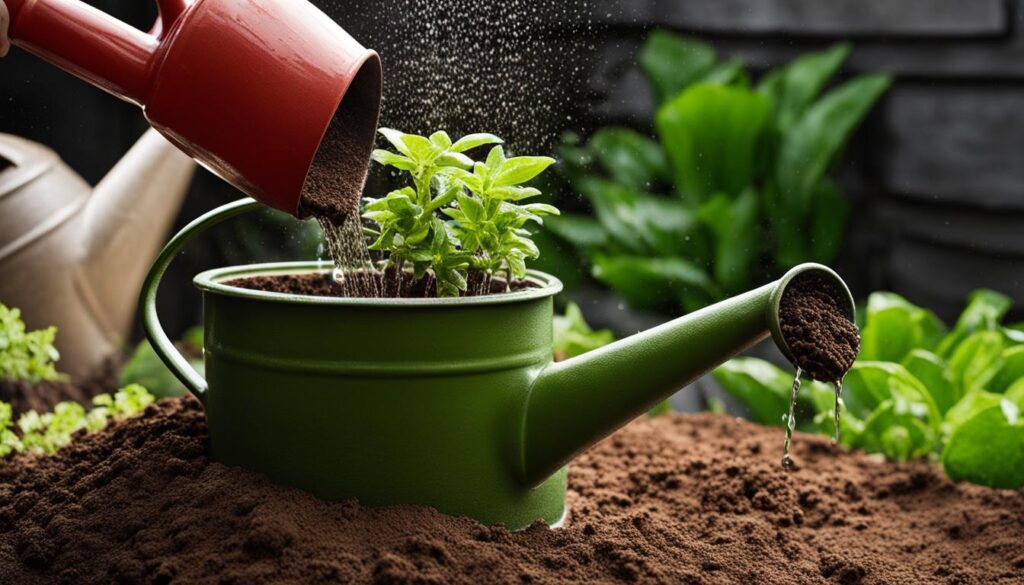
When potting soil becomes too dry and water-repellent, it can be challenging to revive it without spending a fortune on expensive wetting agents. Luckily, there are simple and budget-friendly solutions to rehydrate your potting soil and ensure your plants receive the moisture they need.
One effective method is to add a few drops of dishwashing soap to the water you use for watering. The soap acts as a wetting agent, helping the water penetrate the dry soil more easily. Simply mix a small amount of dishwashing soap with water and apply it to your plants as you would normally water them.
If you have smaller pots, another technique is to immerse them in a tub of water or the kitchen sink. By allowing the pots to sit in water, the soil will slowly absorb moisture from below. Leave them submerged until the soil has rehydrated and the water level in the tub or sink stops decreasing.
With these simple tricks, you can re-wet dried out potting soil without breaking the bank. By using dishwashing soap or immersing your pots in water, you can save money on expensive wetting agents while ensuring your plants thrive in well-hydrated soil.
Pretty Pot Ideas from Junk
When it comes to finding unique and budget-friendly plant pots, you don’t have to look further than your own home. With a little creativity and repurposing, you can turn everyday items into charming containers for your indoor plants. Not only will you save money, but you’ll also add a touch of personal style to your plant collection.
One option for DIY plant pots is to repurpose chipped or cracked mugs and bowls. These containers can still provide a suitable home for your plants, as long as they have proper drainage holes.
By adding a layer of small rocks or pebbles at the bottom of the pot and using a well-draining potting mix, you can ensure that excess water can escape and prevent root rot.
If you’re feeling more adventurous, you can repurpose ordinary food cans into unique plant pots. Make sure to thoroughly clean the cans and remove any sharp edges.
To provide proper drainage, punch several holes in the bottom of the can using a nail or a drill. You can then decorate the cans with paint, fabric, or even decoupage to give them a personalized touch.
Table: Repurposed Plant Pot Ideas
| Repurposed Item | Idea |
|---|---|
| Mug or Bowl | Drill drainage holes at the bottom and use a well-draining potting mix. |
| Food Can | Clean thoroughly, punch drainage holes, and decorate to your liking. |
| Teacup or Saucer | Use as a decorative pot for small plants or as a plant saucer. |
| Old Boots or Shoes | Fill with soil and plant trailing plants for a whimsical touch. |
Additionally, you can repurpose teacups or saucers as charming plant pots or use them as decorative saucers for your existing pots. They add a touch of elegance and can be easily found in thrift stores or as a part of a vintage china set. The small size of teacups makes them perfect for small plants like succulents or herbs.
If you’re looking to add a whimsical touch to your indoor garden, consider using old boots or shoes as unique plant pots. Fill them with soil and plant trailing plants that will cascade down the sides, creating a visually interesting display. This repurposing idea works particularly well for outdoor garden areas or as a fun decor element on a porch or balcony.
With a bit of imagination and repurposing, you can turn almost anything into a pretty pot for your plants. Whether it’s a chipped mug, a food can, or even an old boot, these DIY plant pots will not only save you money but also give your indoor garden a one-of-a-kind charm.
Choosing Affordable Houseplants
When it comes to building a collection of houseplants on a budget, there are plenty of affordable options to choose from. By opting for more common and readily available varieties, you can bring greenery into your home without breaking the bank.
Here are some budget-friendly houseplants that are not only affordable but also low-maintenance, making them perfect for beginners and those with busy schedules.
1. Pothos
The Pothos plant, also known as Devil’s Ivy, is a popular and affordable choice for indoor gardening. It has heart-shaped leaves that come in various shades of green, making it a visually appealing addition to any space.
Pothos is known for its ability to thrive in a wide range of lighting conditions, from low light to bright indirect light. It can also withstand periods of neglect and inconsistent watering, making it a forgiving plant for beginners.
2. Snake Plant
The Snake Plant, also known as Mother-in-Law’s Tongue, is another affordable and low-maintenance option. It has long, upright leaves that are typically green with yellow or white variegation.
Snake plants are known for their ability to purify the air by removing toxins, making them a great choice for improving indoor air quality. They can tolerate a wide range of lighting conditions, from low light to bright indirect light, and only require occasional watering.
3. Spider Plant
The Spider Plant is a classic houseplant that is known for its arching leaves that resemble spider legs. It is an affordable option that is easy to care for and propagate.
Spider plants thrive in bright, indirect light but can tolerate lower light levels as well. They are also known for their ability to produce small plantlets or “spiderettes” that can be easily propagated and shared with friends, allowing you to expand your collection without spending additional money.
When choosing affordable houseplants, it’s important to consider their care requirements and ensure they match your lifestyle and available light conditions.
By selecting low-maintenance plants like Pothos, Snake Plants, and Spider Plants, you can enjoy the benefits of indoor greenery without breaking the bank.
| Houseplant | Light Requirements | Watering Needs |
|---|---|---|
| Pothos (Devil’s Ivy) | Low to bright indirect light | Allow the top inch of soil to dry out between waterings |
| Snake Plant (Mother-in-Law’s Tongue) | Low to bright indirect light | Allow the soil to dry out completely between waterings |
| Spider Plant | Bright indirect light | Keep the soil lightly moist, but not soggy |
Swapping and propagating plants
Plant propagation is a fantastic way to expand your indoor plant collection without breaking the bank. By sharing plant clippings and engaging in plant swapping, you can acquire new plants for free or at minimal cost. Not to mention, it’s an exciting and rewarding process that allows you to witness the growth and development of new plants.
There are various methods of plant propagation, but one of the simplest and most common is through cuttings. Choose a healthy stem from your existing plant, cut it at a 45-degree angle just below a node, and remove the lower leaves.
Place the cutting in water or soil, making sure to keep it moist and provide it with indirect light. Over time, roots will develop, and you’ll have a brand new plant to enjoy.
Plant swapping is another budget-friendly way to expand your collection. Connect with other plant enthusiasts in your community or online and exchange plants that you no longer want for new varieties.
Not only will you save money, but you’ll also build a network of fellow plant lovers who can offer advice and support.
Whether you choose to propagate plants or participate in plant swapping, remember to label your cuttings and new acquisitions. This will help you keep track of the different species and ensure proper care.
By taking advantage of these cost-effective methods, you can grow your indoor garden and enjoy the beauty of a diverse collection without straining your wallet.
FAQ
How often should I water my indoor plants?
Most plants prefer slightly damp soil, like a squeezed out sponge. You can gauge when to water your plants by feeling the surface of the soil and digging your finger into the soil at the side of the pot. This will help you determine if your plants need water or if they can wait a little longer.
How can I clean and shine my indoor plant leaves?
Instead of buying expensive leaf polish, you can clean and shine your indoor plant leaves using simple household items. You can give your plants a ‘rain’ by placing them in the shower or gently rinsing their leaves outdoors. For an extra shine, you can dampen a sponge with milk or mayonnaise and gently wipe each leaf.
How can I make my own plant food?
Instead of buying expensive commercial plant foods, you can make your own plant food at home using common household items. A simple recipe consists of baking powder, Epsom salts, saltpeter, ammonia, and water. Another budget-friendly option is to feed your plants with the water from your aquarium when you clean it – it’s great for plant nutrition.
What is the best potting mix for indoor plants?
It’s important to use the right potting mix for your indoor plants to ensure their health and growth. While commercial potting mixes are convenient, you can also create your own mixture using compost or leaf mold from your garden. Mixing it with river sand and washing out any excess salts will provide a cost-effective alternative.
How can I rehydrate dry potting soil?
If your potting soil has become too dry and repels water, there’s no need to buy expensive wetting agents. You can simply add a few drops of dishwashing soap to the water you use for watering. This will help the water penetrate the soil and rehydrate it properly. You can also immerse smaller pots in a tub of water or the kitchen sink to allow the water to be absorbed from below.
How can I create attractive plant pots on a budget?
Instead of buying expensive ceramic or decorative plant pots, you can repurpose items from your home. Chipped or cracked mugs, bowls, or even ordinary food cans can be transformed into unique plant pots. Just be sure to provide proper drainage if using cans. You can also cover containers with cloth, foil, or gift wrap to create attractive decor.
What are some affordable houseplants to choose from?
When shopping for houseplants on a budget, it’s best to choose more common and affordable varieties. Plants like pothos and snake plants are often more affordable compared to rare or trendy varieties. Opt for low-maintenance plants that can handle varying light conditions and inconsistent watering to ensure they thrive without costing a fortune.
How can I expand my plant collection without spending extra money?
One of the best ways to expand your plant collection on a budget is by propagating plants through cuttings. With proper techniques, one plant can quickly turn into many, allowing you to share with friends or expand your indoor garden. Some plants, like Tradescantia zebrina or inch plant, are particularly easy to propagate.

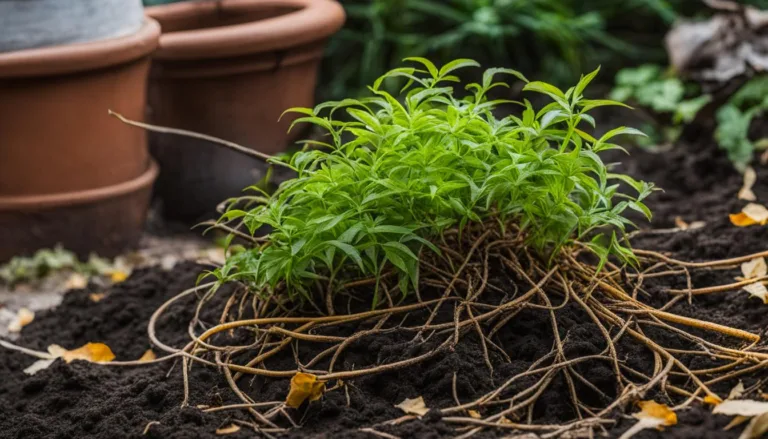
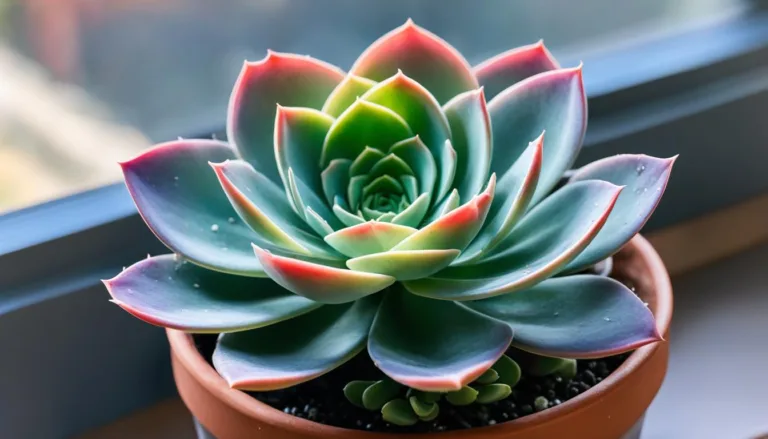
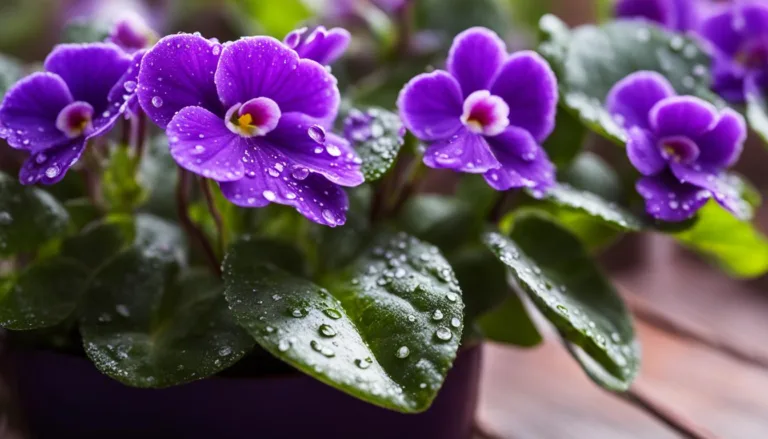
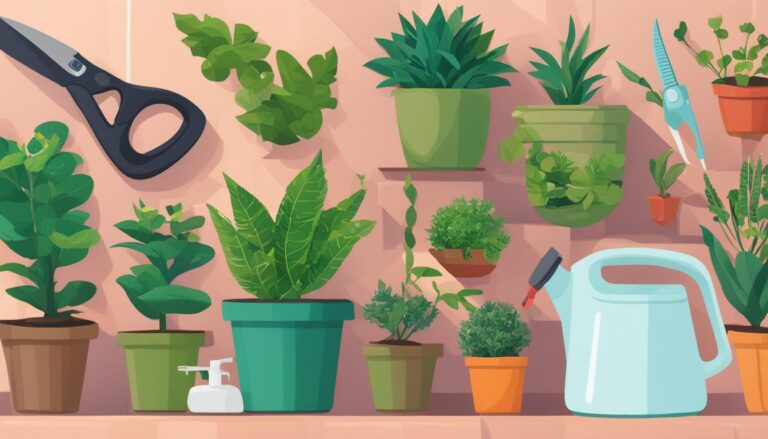
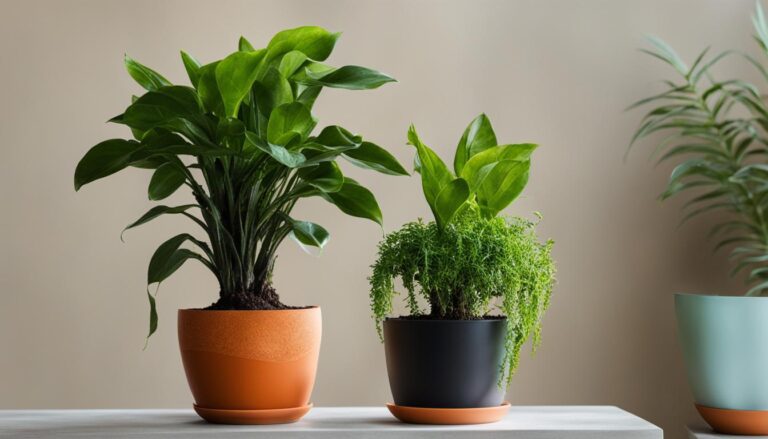
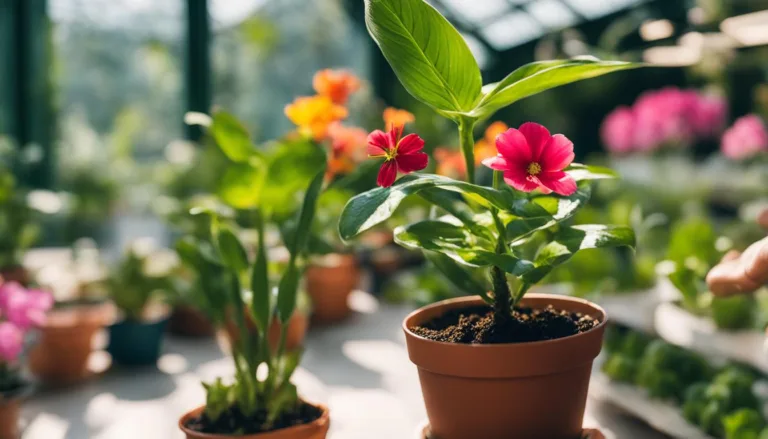
One Comment
Comments are closed.